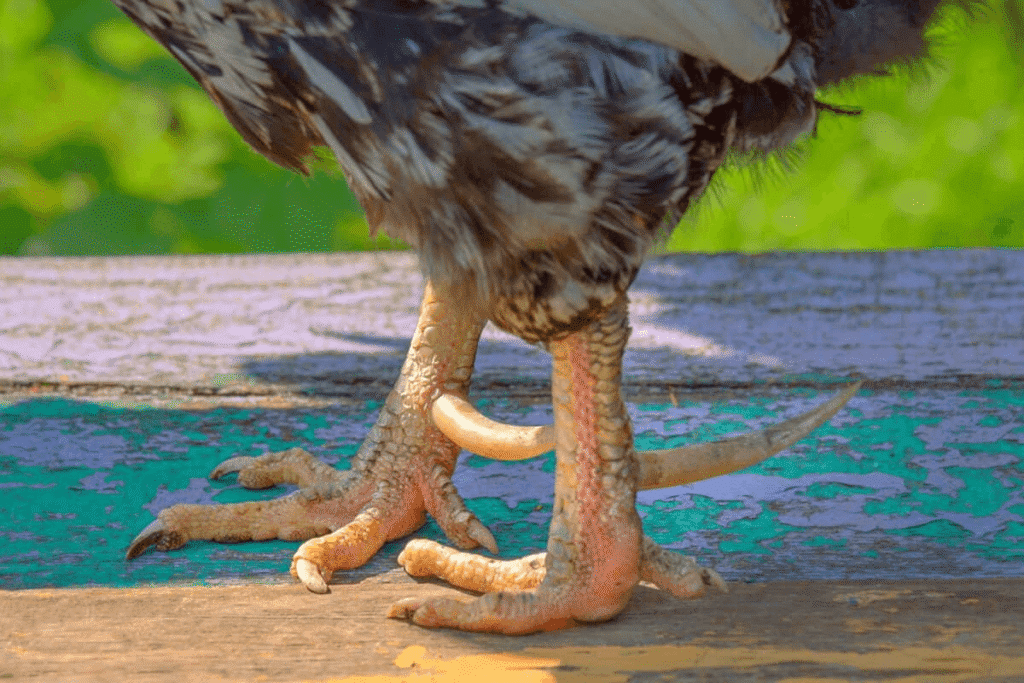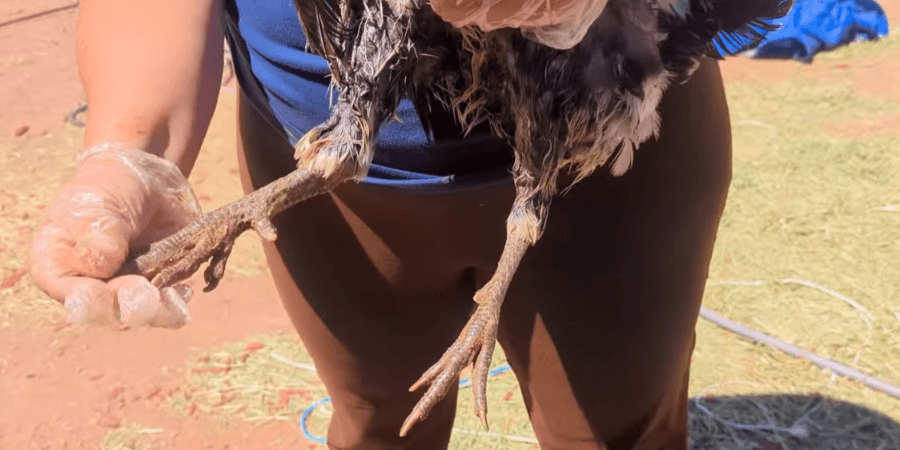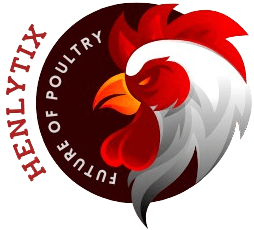From my years of raising roosters, I’ve seen how their spurs can turn from tiny spur buds on young birds into long, sharp projections that gradually grow from the shanks above their toes. Some breeds like Sumatra or even certain Mediterranean lines such as Leghorns, Andalusians, and Sicilian Buttercups are known for having multiple spurs on each leg, sometimes up to five, which can be amazingly large compared to the rarer local stock.
I’ve handled hens too that develop unexpected spurs as they get older, often matching their brothers in size, which makes them just as likely to use these natural weapons to defend their flocks. When a chicken attacks, it propels itself forward with its feet, aiming to slash a target, and I’ve learned through hands-on care how serious these encounters can be. Watching their movements has taught me that spurs are not just ornaments but essential tools for survival in the flock.

An x-ray shows how the tip of the spur is solidly made of keratin-rich, horny material that covers a toenail, whether in a bird or a human, yet this part is dead with no nerve endings or blood supply. But about halfway down lies an inner core of living tissue and bone, an extension of the shank, making the spurs more analogous to horns than nails. This mix of biology and experience helps me decide the safest way to manage them.
How to Remove Rooster Spurs-the solution
Trimming rooster spurs requires care to avoid hitting live tissue. The safest time is at night when roosters are calm, and using clean tools with styptic powder helps prevent injury. A Dremel is often safer than clippers, though it may stress the bird. Improvised tricks, like using hot potatoes, are dangerous and should be avoided—safe, gradual trimming or a vet’s help is best.
Why Trim Spurs?

I’ve often noticed that a spur that keeps growing back into a rooster’s leg must be trimmed, and there are many compelling reasons for it. The most often mentioned and main one is that spurs act as sharp weapons. Certain roosters can be real jerks, quick to attack anyone entering the coop, as if it were their private domain to protect.
Even my own roos, usually quite mellow, sometimes switch moods. Emile, for example, guards his girls on the roost, sometimes suffering from existential crankiness. Facing a bundle of feathered fury is never pleasant, and in those situations, knowing the furious bird is only wielding a shortened and blunted spur brings real relief. In this way, you can see what a rooster symbolize—courage, protection, and the instinct to defend its flock.
Still, not every nonchalant, laid-back, affable, or peace-loving dude shows that kind of aggression. But I always trim for the ladies. When a rooster mounts a hen during mating, the damage from sharp spurs can be harsh. Even with protective saddles for hens, steady trimming helps prevent rooster-damage.
Some hens’ cases are more situational. A wet temper may not lead them to use their weapons, but older hens often struggle to walk when their spurs develop, curl, and grow into their shanks. I’ve seen this with Ida, and trimming then becomes necessary.
There is also the matter of defense. While spurs protect against predators, they cause problems in intimate moments or if a rooster comes flying straight at you. Long spurs are truly dangerous and can be compared to unchecked fingernails—too long, too unhandy, and needing care occasionally. Much like toenails, they can’t be ignored.
If left untrimmed, spurs may scrape the inside of the legs, leaving the rooster unhappy or even lame. That’s why, any day, this isn’t just a random subject, but a vital step to avoid real problems before they grow worse.
Preparing to Trim
When I first learned to trim a rooster’s spurs, I quickly realized that having a faithful friend or close relation with steady hands makes the whole event far easier, since someone must hold the bird firmly while you work. I like to make it a moment of calm, sometimes offering a cup of coffee and a plate of cookies—even the saltines I once kept hiding in the pantry came in handy for a little break.

For the actual trimming, a hacksaw with a sharp blade works well, though an electric or battery-operated hand saw with a fine new edge can also be used. In a pinch, I have even relied on a dog nail clipper to get the job done.
Keep a small amount of cornstarch or styptic powder nearby, just in case the stump bleeds, because that extra step is always a good idea. I often remind myself that the little things I do—like checking the ones I trust to help, being patient with him/her, or thinking under pressure about what tool to get out—all make the task smoother and safer.
And when it’s over, it feels right to share something sweet afterward, knowing you’ve learned something new and built confidence in the process, even if you’re the one saying “you’re braver than me” to your helper.
These same practices are just as helpful when caring for specific breeds, such as the gentle Silkie Rooster, which often requires a little extra patience due to its unique feathering and temperament.
Keeping Your Roo Safe
From my time working with chicken keepers on the farm, I’ve learned that good advice goes a long way when you need to trim the spurs of a rooster. The job may seem simple, but without the right tools and a clear way to do it, things can go wrong. My rule has always been to avoid hurting the roo, because that eliminates the risk of stress and injury. I remember my first try—like many others, I thought there’s just one method, but it seems there are preferred choices depending on when and how you do it.
Some common spur-trimming recommendations are not as safe or effective as they sound, so it helps to read and learn before you accomplish this feat. On our farm, where roosters not only protect hens but also fertilize eggs, we follow steps that make the work smoother. I think it’s not bad to test a couple of different tools to see what works best, because there’s no single answer for them all. You may not expect it, but even a small change in technique can help.
Therefore, knowing what to use and when makes the task easier. If you keep in mind that “they are not just birds, they are part of my care,” then trimming becomes less about force and more about skill. For me, trimming is not only about the spurs, it is also about patience—this is something I keep reminding myself every time I handle it.
Spur Trimming Methods and Care

When I prepare for trimming, I always form a mental picture of the inside of the spur. If you go too closely to the shank, you may cut live tissue or even hit the bone. Choosing the right place makes it simple and nearly painless, like clipping toenails. I remind myself that this job is often a two-person task—one must hold the squirming, sometimes frightened rooster, while the other can wield the tool.
The easiest time for trimming is after bedtime, when the chickens are groggy and subdued, making them much easier to manage. Whether in the coop, under a lighted spot, or with a headlamp in the dark, I always bring a jar of styptic powder to stop bleeding if I cut too deep or accidently slip.
Roosters with overgrown spurs often face injury, difficulty walking, or lasting discomfort if not maintained. Just as Roosters Crow to mark their presence, their spurs also demand attention, and neglect can cause serious issues. Among common methods are twisting the sheath or cutting partway down.
Both carry risks of pain and can be done improperly, so great care is needed to avoid harming sensitive areas. Using clean, sharp tools, and applying styptic helps. Regular inspection and gradual work prevent damage. For severe cases, it is best to consult a vet if you feel unsure of your technique.
An advantage of the Dremel is that it sands instead of cuts. The process is gradual and less likely to hit the quick or living part, reducing the cause of pain. If you venture too far, the result may only be a small, superficial cut. By contrast, clippers, especially dull ones, can pinch or crack the spur, resulting in further damage. That is why, in my view, the Dremel—despite its flaws—is often the safer choice.
The downside is that the Dremel is bulkier than a clipper and makes a humming noise. This can leave the rooster stressed and add to his anxiety. The method can extend the period of stress, making the trimming slower.
The waving of a big, scary, noisy thing doesn’t help either. Sure, you can adapt, but regardless, how you use it really makes the difference. During training, I even practiced with ones that were already trimmed, just to test my control.
Over the years, I’ve heard unusual stories. One young lad, while outdoors and chawing a fresh, hot, baked potato, met a mean, ole bird charging at him. In his fright, he threw the spud, which became lodged on the bird’s spur. Though the spur looked trimmed, the method was dangerously crude. He was left in astonishment at how quickly the spur came off, leaving a pale, bloody stub behind. It may have came off, but such tricks should never be seen as safe.
I’ve even heard of people like Ida, a fellow who let his roosters live with long spurs, thinking that to leave them was apparently fine. In fact, those spurs had become sharp, dangerously long, and hard to manage. Some say the heat from a potato can burn the skin at the base of the spur, leaving a tender nub that can be painful until the spur grows and hardens again. This could hurt the poor bird.
In one case, a temperamental roo left a lad running, and in my opinion, such practice is barbaric, best abandoned. Whether new or old, improvised methods may seem novel, even humble, but they carry risks and could cause burns or lasting tenderness. The correct approach is to remove spurs with care, not with leftover tricks like starch, a supper leftover, or some odd tale from the past. I would rather follow safe methods than gamble with harm.
Spa Day in the Coop
When poultry care comes around, I prefer trimming at bedtime, because the guys on the roost are calmer. We nabbed them one at a time, and with a steady holder and careful trimmer, the job was fast. I used a clipper in that session, making a single clip per spur.
Even though we had styptic on hand, we didn’t need it. After the trim, each bird was in place. I, the keeper, was glad this routine had been completed, because it brought peace into the coop.

The roo who went first seemed a little stressed, almost frantically thinking about what was happening. In no time, he was back with a shortened spur, no longer threatening to grow into the shank.
I was sure the deal felt huge for him, but the trim made life healthier. Fairly speaking, it’s not always easy, but it’s worth it. He was calmer, and so was I. That moment reminded me the care is not just the cut, but also patience and trust.
Another bird at the rear had amazingly large spurs, almost too big for the clippers. This Wyandotte Rooster from a Hen line was easy to notice—his silly, curly feathers and smallest size at the bottom of the pecking order showed he needed care. I worked quickly and painlessly, and he was soon standing securely, enjoying the comfort of the coop.
In fact, the spurs barely fit, but trimming went a long way toward assuaging his self-esteem. It was a task I would not ignore. I knew I must have courage and be able to use the right tools, and I felt proud when the work was complete.
It’s a nice reminder that trimming isn’t just about spurs, but about flock life. Sometimes the work benevolently evens things. It restores calm. Even when it feels heavy, you learn that you are shaping balance.
They and I share this moment, because trimming is as much for me as for them. It’s a small ritual where we remember what is, what was, and what could be. So, trimming becomes more than a task; it’s about care, safety, and balance for the flock.
Frequently Asked Questions
Does removing rooster spurs hurt?
Yes, removing a rooster’s spur is a painful procedure since spurs contain a sensitive inner core of live tissue and bone, similar to a human fingernail. Though roosters may not show it because of prey animal instincts, it feels comparable to pulling a nail off, so it’s best avoided with trimming.
If they must be removed, veterinarians recommend using anesthetic and appropriate pain management to humanely perform the task.
Are you supposed to trim a rooster’s spurs?
Yes, you should trim a rooster’s spurs and not remove them entirely unless absolutely necessary, since it can be painful and lead to infection. They grow continuously like fingernails, so you must prevent them from getting too long, curving into the foot, or causing injury to chickens.
Simply clip the extra length with heavy-duty nail clippers, then use a Dremel tool or grinder to smooth the round sharp edges, similar to filing. Be cautious not to cut too far back and avoid hitting the quick, a blood vessel.
What is the best tool for trimming rooster spurs?
When spurs grow large, the best way is to use strong cutting tools instead of relying only on small clippers. A fine-tooth hacksaw can work well, whether manual or reciprocating electric, but many keepers find that a Dremel tool fitted with a cutting wheel gives smoother edges and more control during the trim.
How to remove rooster spurs with hot potatoes?
One old method places the potato directly onto the spur, almost like you spear it, and you hold it there for several minutes before you remove the potato. After that, you take a pair of pliers and gently twist and pull at the same time, which can loosen the spur enough for it to come off.
Conclusion
Caring for roosters means learning safe ways to manage their spurs, and whether you use clippers, a Dremel tool, or even older tricks like the potato method, the goal should always be to protect the bird from pain, injury, or infection. By trimming carefully, choosing the best tools, and handling the process with patience, you not only keep the flock safe but also make life more comfortable for the rooster, showing that proper care is about balance, responsibility, and respect.


